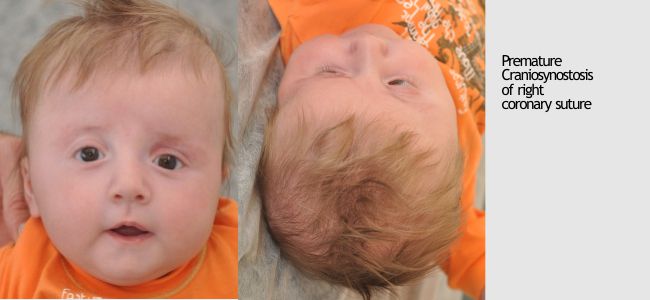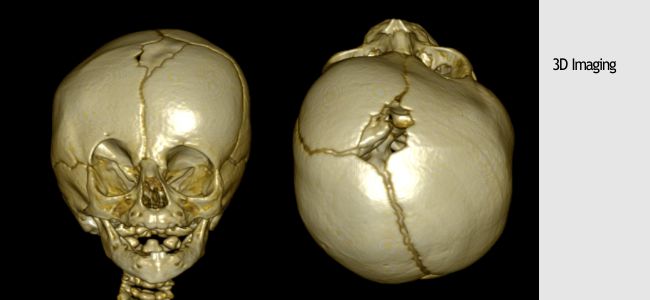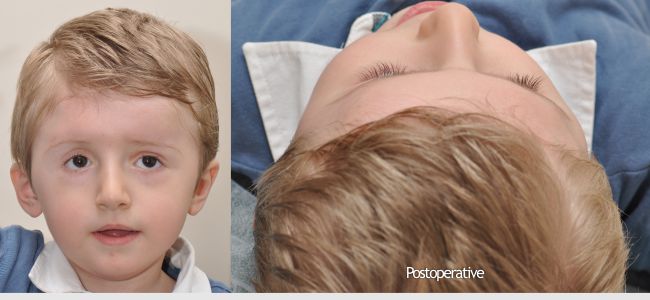Photos and Text Source: Hellenic Craniofacial Center (HCC). HCC was founded by the late Dr. Alexander Stratoudakis and is directed by Dr. Costas Alexandrou, Craniofacial Surgeon, Member of the Cyprus Center for Cleft and Facial Deformities, MEDICLEFT;
NON-SYNDROMIC (PLAIN) CRANIOSYNOSTOSIS
Cranial sutures and premature craniosynostosis
Craniosynostosis is the early fusion of two or more bones of the skull. Baby skull consists of bones which have not yet joined to each other but are connected by flexible links called cranial sutures. Since in the early stages of life the brain has particularly strong growth potential, bones, succumbing to the pressure of the developing brain are dissociated from one another, allowing the smooth development of the brain and skull. When the development of the brain stops, cranial sutures lose their functional importance and they no longer have a reason for existence, so they are covered by bone and bones are joined to each other.
The early synostosis, i.e. the early union of the bones, prevents the normal development of the skull and brain and induces morphological (changes in the normal shape of the head), functional, as well as developmental problems in children. If a suture between two bones fuses prematurely then the skull cannot grow naturally and bones will still have open sutures that will grow more countervailing so as not to limit the growth of the brain. This results in the further development of a malformed skull.
Diagnosis
Craniosynostosis may be evident at birth or it might be observed later. It is diagnosed by physical examination, usually in combination with diagnostic imaging. During the examination a complete medical history is taken and the necessary measurements are made.
Surgical recovery
Each patient is individually evaluated based on the following parameters:
- Age
- Health Status and body weight
- Type and extent of craniosynostosis
Therefore the plan of each case is completely personalised based on the specific needs of the child. Usually treatment is possible only with surgery. The aim is to correct the shape of the skull so as to allow the normal development of the brain and the shape of the skull and the reduction of intracranial pressure if there is any.
Nowadays specialized surgical cranioplasty surgeries are specifically performed to restore the skull and facial skeleton deformities. These surgical interventions, are performed as a general rule during the first months of life in order to take advantage of the increased capacity of the tissue (the periosteum and crestal dura) to form the bone after surgery.
The cranioplasty procedures must be carried out by specialized ΤΕΑΜ in Craniofacial Centers by scientists and doctors with training extensive experience in this type of patients.
Problems accompanying craniosynostosis
- Brain pressure phenomena.
In individuals with craniosynostosis the brain is pressed from lack of space created and thus this area cannot be supplied by adequate blood. The consequence of this may be the incomplete creation of synapses among nerve cells that are necessary for the normal development of the nervous system.
- Intracranial hypertension
The pressure exerted on the brain from the overlying deformity of the skull may cause increased intracranial pressure, namely generalized intracranial hypertension, or practiced locally only in part of the brain located below the deformed bone. This problem is more frequent than previously thought and the higher rates we observe are in premature closure of the sagittal suture (scaphocephaly).
- Progressive premature closure of other sutures
Early closure of coronal suture has been observed after surgical correction of scaphocephaly. This problem prevents the simultaneous removal of coronary suture in the correction of scaphocephaly.
- Ophthalmological problems
From non syndromic craniosynostosis, the frontal plagiocephaly is often accompanied very often by ophthalmological problems. the most common of which are:
- Strabismus, ie the eyes do not see one image, but two, consistently one image to be thwarted causing amblyopia in one eye. The eye that suffers is usually from the healthy side and not from the side of the lesion. This problem is completely curable if diagnosed in time, and is almost exclusively observed in the frontal plagiocephaly.
- Swelling of the optic papilla is a sign of intracranial hypertension.
It is clear, therefore, that the regular eye examination of children with early synostosis of cranial sutures is mandatory.
- Cognitive and learning disorders
They are observed in increased frequency in children with non syndromic craniosynostosis and they occur during preschool age. It has not been clarified whether they are caused by craniosynostosis or if simply they are due to the same gene that causes them. An evaluation is recommended by a pediatrician once a year from the age of two and thereafter so that if this problem is suspected an early therapeutic intervention to be scheduled.
Prognosis
Prognosis of non syndromic craniosynostosis is generally good if the appropriate intervention is performed in time and the child continues to be monitored regularly by the craniofacial team. Children are expected to live normal lives without restrictions, with distribution identical to that of the general population.
If you need any information about the treatment of clefts and other facial deformities, please contact + 357 25735050 or send us an e-mail at [email protected].
We will be next to you throughout the treatment procedure…






